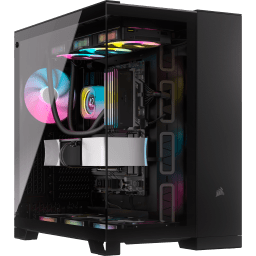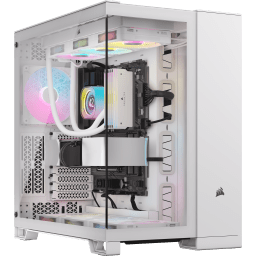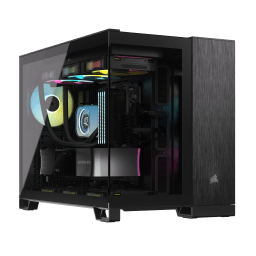MSI Project Zero og ASUS BTF er begge initiativer, der ønsker at ændre spillet, når det gælder bundkortdesign. Specifikt flytter de stikkene til bagsiden af bundkortet for at give et renere udseende. Et sådant paradigmeskift er dog ikke uden udfordringer, først og fremmest med hensyn til kabinetkompatibilitet, og det er her, CORSAIR kommer ind i billedet.
Siden starten har CORSAIR været på forkant med computerteknologi og har været hurtig til at tilpasse sig for at støtte konventionsbrydende innovationer som denne. Lad os se på, hvad disse omvendte bundkort handler om, og hvordan CORSAIR støtter Project Zero og ASUS BTF - som står for Back-to-The-Future, hvis du skulle være i tvivl).


MSI Z790 Project Zero
ASUS ROG MAXIMUS Z790 HERO BTF
Hvorfor skal kablerne overhovedet sidde på forsiden af bundkortet?
Traditionelt har alle portene på et bundkort vendt fremad, vinkelret på printkortet og væk fra bundkortbakken. Dette sikrer kompatibilitet, da alle disse kabler straks kommer ind i det frie rum inde i kabinettet og derefter føres tilbage til PSU'en.
Funktionelt er det fint, men målet om at få disse kabler til at se pæne ud er så udfordrende, at der er opstået en hel industri for at gøre det meget nemmere. Skræddersyede sleeves, kabelkamme, kabler i tilpassede længder, flade kabler, runde kabler, retvinklede adaptere osv. osv.
Men hvad nu, hvis man ikke behøvede at bekymre sig om noget af det? Tænk, hvis portene til disse kabler kom direkte fra bagsiden af bundkortet. Når alt kommer til alt, skal disse kabler alligevel tilbage dertil for at finde vej til strømforsyningen. Det virker som en no-brainer, men som med alle andre "no-brainer" dækker den tilsyneladende enkelhed over betydelige tekniske og ingeniørmæssige problemer.

Hvordan CORSAIR hjælper det omvendte bundkortkoncept med at blomstre
Opdatering: Vi har fjernet mATX-bundkort med omvendt stik (Micro-ATX) fra 6500-serien af kabinetter, da det viste sig, at PSU'en blokerede nogle stik. ATX-bundkort med omvendt stik er ikke berørt og er derfor fuldt kompatible.
Vi nævnte, at kabinettets kompatibilitet er det største problem, men mere præcist er det bundkortbakken, der er det vanskelige aspekt her. Det er ikke let at ombygge en så vigtig del af kabinetdesignet til helt nye standarder uden at gå på kompromis med noget andet.
Fra og med CORSAIR 2500/X og 6500D/X dobbeltkammerkabinetterne (fås 27. februar) har vi redesignet bundkortbakken og lavet udskæringer, der passer til placeringen af de omvendte stik. Disse kabinetter er kompatible med MSI Project Zero- og ASUS BTF-portlayouts, samtidig med at de også understøtter traditionelle bundkort.
Galleriet nedenfor viser billeder af 6500D/X- og 2500D/X-kabinetterne. De ekstra slots rundt om bundkortbakken svarer direkte til de nye portplaceringer for MSI Project Zero og ASUS BTF.
Det er værd at bemærke, at det ikke kun er CPU 8-pin og ATX 24-pin kablerne, der er i fokus for disse ændringer, det er alt. Blæserhoveder, front-I/O og SATA-porte, de gemmer sig alle sammen på bagsiden nu. Når man laver huller i bundkortbakken, bliver den selvfølgelig mindre stiv, men det er lykkedes os at bevare styrken i denne sektion ved hjælp af smart ingeniørarbejde under designprocessen af 2500D/X- og 6500D/X-kabinetterne.
Der er dog et andet problem, der skal løses. Da portene stikker lige ud af bagsiden af bundkortet, ville kablerne i et traditionelt kabinet blive stoppet af sidepanelet og være nødt til at foretage en drastisk 90-graders drejning. At bøje kabler lige ved porten er en kardinalsynd for pc-byggere, da det kan beskadige kablerne, trække stifter ud og i nogle meget alvorlige tilfælde rive porten helt af bundkortet. Dette er især problematisk for USB 3.0-headere, da de er notorisk stive og har brug for mindst et par centimeters frihøjde lige ud af porten, før du virkelig kan begynde at bøje kablet.
Disse problemer er blevet løst med dobbeltkammerdesignet på 6500D/X og 2500D/X. Det bageste kammer er dimensioneret til at passe til en ATX PSU, så der er plads nok til kablerne på ATX BTF- og Project Zero-bundkort. Det gør det muligt for det nye omvendte bundkortkoncept at fungere uden problemer, idet alle porte og kabler fjernes helt fra synsfeltet. Det resulterer i de pæneste, slankeste og mest moderne builds til dato.
Med CORSAIR 6500D/X- og 2500D/X-kabinetterne, der understøtter de nye ATX-bundkortdesigns fra MSI og ASUS, kan gamere endelig bygge pc'er med forbrugertilgængelige produkter, der ser lige så raffinerede og rene ud som enhver brugerdefineret DIY-løsning derude.
Fra LAB
Her er en video, som viser, hvordan vores kommende 6500D/X- og 2500D/X-kabinetter, som vi afslørede på CES, vil fungere sammen med BTF og Project Zero.
Mens vores nye 6500- og 2500-kabinetter understøtter MSI Project Zero- og ASUS BTF reverse-bundkortdesigns, skal det bemærkes, at andre mærker arbejder på lignende koncepter, for eksempel GIGABYTE med deres Project Stealth. Men i skrivende stund er det kun MSI's og ASUS' design, der er kompatible med CORSAIR-kabinetter.
PRODUKT REGISTRERING











